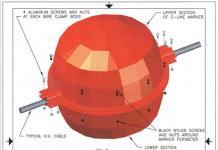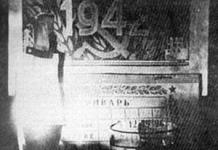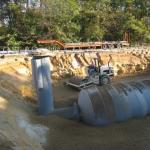Today, each of us has a huge number of expensive electrical appliances installed in our apartments. And of course you want to always have “stable” 220 Volts in the sockets, so that the equipment works properly and is protected from overvoltage.
But in reality, everyone has had unpleasant moments at least once in their life, and it was not even you who were to blame, and not the quality service of electrical equipment by energy grid companies.
Only after this do most users think about whether it is possible to protect themselves and protect themselves from these moments, while incurring minimal costs. Everyone gets out to the best of their financial capabilities. They buy uninterruptible power supplies for expensive equipment, voltage stabilizers, or install stationary ones in an electrical panel. At the same time, in order to do this, you need certain knowledge. 
What to do if there is no space in the panel, but there is no desire to invite an electrician or redo the wiring? In this case, a voltage relay in the socket will help you. Here is a comparison table of the two most common brands:
| Options | Relay RN-101M | Relay Zubr R116y |
|---|---|---|
| Lower voltage cut-off limit | 160V | 120V |
| Upper voltage cutoff limit | 280V | 280V |
| Automatic reclosure time | 5-900 sec | 3-600 sec |
| Minimum shutdown time | 0.12 sec | 0.05 sec |
| Working temperature | from -25 to +40 | from -5 to +45 |
| Overload protection | There is | No |
| Surge protection | There is | No |
| Calibrating Voltage Readings | No | There is |
| Switch off the load with a button | No | There is |
| Price | 1700 rub. | 1400 rub. |
Let's take a closer look at each of them.
Voltage relay for socket RN-101M
 It is produced by the famous Russian company Novatek-Electro.
It is produced by the famous Russian company Novatek-Electro.
Device specifications:

Very frequent overvoltages in the 220V network occur precisely when electricity is turned on at a substation after a long period of inactivity, caused by various reasons (scheduled repairs or repair of damage after a short circuit). This has an extremely detrimental effect on the operation of household appliances such as a refrigerator. By connecting it not directly, but through a socket-type relay RN-101M, you can set the restart time.
What it is? This is the time after which the relay itself will turn on after voltage is supplied to the apartment. For RN-101M it can be set from 5 to 900 seconds. Thus, voltage will be supplied to your device after all transient processes, without the risk of failure of the motor or other elements.
In addition, a surge protector is mounted inside the device. It protects electronics from high-voltage network interference. And for protection against overloads there is an internal circuit breaker for current up to 15A. In general, this is not a socket, but a whole complex of protections in a miniature case. 
There is an automatic overload protection button on the upper left side of the case. When the machine knocks out, to turn on the relay, the button must be pressed down, like the old automatic traffic jams in the meter panel. 
On the right is a digital indicator. Below it is an LED that records the state of the load (on-off). And adjustment buttons: minimum, maximum voltage and AR time.
Be careful with refrigerators and other compressor equipment. For them, you cannot set a threshold lower than that allowed by the factory instructions. So if you don’t have it, try to find it at least on the Internet.
In addition, the automatic restart time delay for refrigerators and air conditioners must be at least 4 minutes.
 Also, do not forget about the error of the device. For example, you found in the documentation that the electronics on your equipment can safely operate at a maximum of 255 Volts. Long work at 256 Volts and that’s it—the death of the device.
Also, do not forget about the error of the device. For example, you found in the documentation that the electronics on your equipment can safely operate at a maximum of 255 Volts. Long work at 256 Volts and that’s it—the death of the device.
You set the setting on the relay in the socket to exactly 255 V, while forgetting that the stated error of the relay is up to 3 Volts. At night, the voltage in the network for a long time exceeds 258 V; this often happens during the hours of minimum load. The relay did not sense it due to an error and did not work, thereby burning all the electronics.
Preparing for work
Plug the relay into the socket. Use the adjustment buttons to set the minimum, maximum voltage and AR time.  In this case, the set value will be displayed on the indicator screen. That's all, the voltage relay is ready for use. You can use it to plug the plug of the protected equipment into the socket.
In this case, the set value will be displayed on the indicator screen. That's all, the voltage relay is ready for use. You can use it to plug the plug of the protected equipment into the socket.
Operation of relay RN-101M
If everything is normal, then the voltage level in the socket is displayed on the display and the LED lights up green.
When a sudden surge occurs, the relay automatically turns off the voltage in the outlet. The LED will no longer light up, and the display will display the increased voltage value in flashing mode. After normalizing the parameters, the indicator starts counting down in seconds, which you set before turning on the load. And upon completion, the relay supplies voltage and returns to normal mode. 
If the voltage is normal, but there is an overcurrent, the internal circuit breaker is triggered. The button snaps off, the LED starts blinking, and the voltage value in the network is still lit on the display. First, find out what caused the shutdown, remove the plug from the relay and press the button, turn on the machine. After this, wait a few minutes for the thermal protection element to cool down and turn on the load again. 
To prevent the relay from triggering falsely, for example, every time the refrigerator is turned on, there is a short-term voltage drop for a few tenths of seconds, a fixed delay was provided in the relay. Even when the voltage drops smoothly and evenly, the device will not turn off immediately, but after 7 seconds. If there is a deep and sharp drawdown (below 145V), the shutdown will occur in 0.12 seconds.
If the specified parameters are exceeded, there is no longer such a long delay, since there is a greater likelihood of equipment failure. And the relay will turn off the power in the socket after 1 second (with a smooth rise). When jumping, the shutdown time is also 0.12 seconds.
The device is absolutely functional in all sockets, even with a grounding conductor, even without it.
The price of a voltage relay for an RN-101M socket is on average 1,700 rubles. But for this price you get three protective devices instead of one!
Voltage relay Zubr R116y
 Zubr R116y is another popular relay model that performs the function of protecting against overvoltage of a 220V network, but from a different manufacturer. Also designed to be easily plugged into a power outlet.
Zubr R116y is another popular relay model that performs the function of protecting against overvoltage of a 220V network, but from a different manufacturer. Also designed to be easily plugged into a power outlet.
Important note: the device must not be connected after a UPS (uninterruptible power supply) as this may damage it.
Its characteristics are as follows: 
It is advisable to connect a load of no more than 75% of that indicated in the passport through the relay socket (rated current 16A, power 3000VA). Why is this so? The fact is that with increased voltage, the power of the same equipment increases.
For example, you connected a 3 kW air conditioner through a relay. But this is its power at a voltage of 220V. And if the upper threshold for shutdown is set to 260V, then the power of the same air conditioner at the time of shutdown will already be 4.19 kW. And when such a load is disconnected, the relay may not withstand it and burn out. To correctly calculate the power allowed for connection, use the formula: 
Main differences from RN-101M:
- ⚡ Limits are adjusted using buttons, which is subjectively more convenient than miniature rotating knobs
- ⚡ faster response time in case of overvoltage
- ⚡ wider range of minimum voltage settings (from 120V)
- ⚡ there is a function to disconnect the load without removing the plug from the socket
- ⚡ there is an adjustment for voltage readings on the display
- ⚡ no overload protection
- ⚡ no protective filter against impulse noise
- ⚡ more heat-loving (the minimum temperature for normal operation is from -5, versus -25 for the RN-101M)
Setting up the voltage relay Zubr R116u
The initial (factory) settings of the response limits are as follows:
- ⚡ Umin=198V
- ⚡ Umax=242V
In general, the recommended limits are + - 10% of the considered standard of 220V. Although according to the new rules (GOST 29322-2014) today the standard is 230V! 
When the relay is turned on for the first time and the relay is operating normally, the green LED lights up and the voltage readings in the socket are displayed on the display.
If you are not satisfied with the factory settings, you can set your own limit values. Press the plus button to set the upper voltage threshold, and press the minus button to set the lower voltage threshold. 
A quick press of the middle button will show what voltage (high or low) caused the relay to turn off last time.
To set the AR (reclose) time, press the middle button 2 times. After that, use the + and - buttons to increase or decrease the time in seconds from 3 to 600. 
Voltage control relay Zubr R116y has load disconnect function without removing the appliance plug from the socket. To do this, press the middle button for a long time (up to 6 seconds), the word OFF will appear and the relay along with the load will turn off. To turn it on, repeat the same procedure. 
Another advantage of the relay is the ability to correct the voltage readings that are displayed on the display. If you are sure that your voltmeter or multimeter shows the correct values, but the relay is “lying” by a few volts, then you can adjust these values to the correct ones. Press the middle button for 9 seconds (until the word PoP appears), and then use the + and - buttons to adjust the voltage to the desired result. 
When the PRG inscription suddenly appears on the screen, do not be alarmed - it is the overheating protection that has tripped. Most likely there was a bad contact in the socket. Because of it, the relay began to heat up, and since it has protection against overheating at contact temperatures above 80C, it worked, preventing a fire. For further operation, the relay must cool down to a temperature of 60C, and by pressing any of the buttons, it will start again.
The cost of the Zubr R116y voltage relay in online stores starts from 1,400 rubles.
To summarize, we can conclude that if you need overvoltage protection for any individual device, a voltage relay in the socket is the best option. No costs for calling an electrician, no alterations with wiring.
But if you simultaneously need protection for several electrical appliances (refrigerator, TV, computer, air conditioner), then you need to look towards a standard relay installed in the panel, since this option will cost several times less.
Although the supply of electricity to apartments and houses is regulated by law, residents should not fully rely on the relevant services to provide the required quality of electricity. If expensive electrical appliances fail due to power surges, it will be almost impossible to receive compensation. And since problems with power lines are not uncommon, it is worth taking measures on your own that will help protect household appliances from breakdown. To do this, you need overvoltage protection, which can be provided by installing an appropriate device in the network - a protective relay, a sensor with an RCD or a voltage stabilizer.
Acceptable electricity parameters
The voltage rating indicated on all household electrical appliances is 220V, but in real life this value is not always stable. This is taken into account in the manufacture of modern devices, and they can operate stably with voltage fluctuations from 209 to 231V, as well as withstand a spread from 198 to 242V. If small differences in potential differences were not provided for by the design of household appliances, they would break down constantly. More significant deviations lead to network overload, and this reduces the operational life of the equipment.

To smooth out voltage fluctuations and ensure the safety of devices, it is enough to install a stabilizer. Overvoltage (the so-called sharp jump in potential difference) is much more dangerous for electrical engineering.
Types of overvoltages
Overvoltage can last for either a short or quite a long time. It can be caused by a lightning strike during a thunderstorm or switching caused by a substation problem. To protect against them, an SPD (surge protection device) is connected to a 220 or 380 Volt network (domestic or industrial). Its automatic operation helps to protect the line when exposed to, for example, a powerful lightning discharge, from which a voltage stabilizer cannot save.
Visually about the SPD in the video:
A lightning strike results in the appearance of a powerful electromagnetic pulse, under the influence of which electrical potentials arise in conductors located near the discharge site, and a sharp voltage surge occurs. It lasts only about 0.1 s, but the magnitude of the potential difference is thousands of volts.

It is clear that when such voltage enters home and industrial networks, the consequences can be very serious.
Overvoltage due to switching
This phenomenon can occur when devices that produce a high inductive load are connected to or turned off in the line. These include power supplies, electric motors, and powerful tools powered from the mains.
This effect is due to the laws of commutation. An instantaneous change in the current value in the solenoid, as well as the potential difference across the capacitor, cannot occur. When a circuit with such a load is connected or opened, the appearance of an electric potential caused by self-induction and switching processes is noted at the point of contact.
The transient process is always accompanied by a surge of voltage, which has the opposite polarity to the input. The small capacitance of the conductors in the network causes a resonance that lasts a short time and causes high-frequency oscillations. At the end of the transition process they fade out.
How long the overvoltage will last and what its magnitude will be depends on the following indicators:
- Load inductance.
- Instantaneous value of the potential difference during switching.

- Capacity of connecting electrical cables.
- Reactive power.
Danger of overvoltage
Since the wire insulation is designed for a voltage significantly higher than the nominal value, breakdown most often does not occur. If the electric pulse operates for a short time, then the voltage at the output of power supplies with a stabilizer does not have time to increase to a critical value. The same applies to ordinary light bulbs - if the sharply increased voltage quickly returns to normal, then the spiral does not have time not only to burn out, but even to overheat.
If the insulating layer cannot withstand the increased voltage and its breakdown occurs, then an electric arc appears. In this case, the flow of electrons penetrates through microcracks that have arisen in the insulation and goes through the gases that fill the resulting tiny voids. And the large amount of heat generated by the arc contributes to the expansion of the conductive channel. As a result, the current increases gradually, and the circuit breaker trips with some delay. And although it only takes a few moments, they are quite enough for the electrical wiring to fail.

What devices provide network surge protection?
An electrical line surge protection circuit may include:
- Lightning protection system.
- Voltage regulator.
- Overvoltage sensor (installed together with the RCD).
- Overvoltage relay.
Separately, it is necessary to say about uninterruptible power supplies, through which computers are most often connected in home networks. This device is not intended to provide surge protection. Its function is different: in the event of a sudden power outage, it works like a battery, allowing the user to save information and calmly turn off the PC. Therefore, it should not be confused with a voltage stabilizer.
Operating principle of protective devices
To protect against electrical impulses caused by lightning, a lightning arrester is installed together with an SPD. And you can protect the line from the flow of electrons, the parameters of which do not correspond to the operating characteristics of the network, using special sensors, as well as overvoltage relays.
It should be said that both the DPN and the relay differ in principle of operation and purpose from the stabilizer.

The task of these elements is to stop the supply of electricity if the value of the difference exceeds the maximum threshold specified in the technical data sheet of the protective device or set by the regulator.
After normalizing the parameters of the electrical line, the relay switches on automatically. DPS for line protection should be installed only in conjunction with a residual current device. Its task is to cause a current leak when a malfunction is detected, under the influence of which the RCD will trip.
Visually about the voltage relay in the video:
The disadvantage of this circuit is that it needs to be turned on manually after the voltage returns to normal. In this regard, a voltage stabilizer compares favorably. This device provides an adjustable time delay for current delivery if it is triggered by excessive voltage. The stabilizer is often used to connect air conditioners and refrigeration units.
Long-term overvoltage
Long-term overvoltages very often occur due to a break in the neutral conductor. Uneven load on the phase conductors causes phase imbalance - a displacement of the potential difference towards the conductor with the heaviest load.

In other words, under the influence of an uneven three-phase electric current, voltage begins to accumulate on the neutral cable, which does not have grounding. The situation does not return to normal until a repeated accident completely puts the line out of action or a specialist fixes the problem.
If the neutral wire in the electrical outlet breaks, the voltage will change in accordance with the load, which users who are not aware of the problem will connect to different phases. It is almost impossible to use a faulty circuit, even if a good stabilizer is included in the power line. The fact is that network parameters that regularly go beyond stabilization limits will lead to the device constantly turning off.
You can see clearly about the zero break and what needs to be done about it in the video:
Lack of voltage (sag)
This phenomenon is especially familiar to people living in villages and villages. A dip (sag) is a drop in voltage below the permissible limit.
The danger of sagging is that many household appliances are designed with several power supplies, and a lack of voltage will cause one of them to turn off briefly. The device will react to this by displaying an error on the display and stopping operation.

If we are talking about a heating boiler, and the malfunction occurred in winter, then the house will be left without heating. Connecting a stabilizer will help avoid this situation. This device, having detected a sag, will increase the voltage value to the nominal value. A stabilizer can save the situation, even if the network voltage drops due to the fault of the transformer substation.
Conclusion
In this article, we explained why network surge protection is needed, what devices provide it, and how to use them correctly. The recommendations given will help readers understand the causes of mains voltage failure, as well as select and install a device to protect the electrical network.
- Engineering systems,
- Electrics
How to organize network surge protection in a private home
The presence of expensive electrical and electronic equipment in the house, natural disasters and poor quality of power supply in urban networks force homeowners to take measures to minimize possible damage from the above factors.
This article will discuss practical measures that can be implemented when organizing power supply to a private home. Moreover, this work can be performed both during new construction and when modernizing existing power supply systems of a private home.
I performed the specified work when converting the power supply at home from a single-phase to a three-phase circuit. Moreover, the work was not only completed, but also accepted by representatives of city power grids without comments, and the correct functioning of the devices and the effectiveness of overvoltage protection were tested in practice during operation. It is known that the main condition for connecting to city electrical networks is the fulfillment of technical conditions (TS), which are issued to the home owner. As personal experience has shown, it is possible to hope that these specifications will reflect all measures for the safe operation of electrical equipment with some skepticism. The photo below shows the specifications issued to me by the city power grid.
Note: the items marked in red in the photo were implemented by me independently even before receiving technical support. conditions. The item marked in blue is more determined by the interests of the city networks themselves (to protect themselves from liability for damage to the owner of the house due to possible problems in their area of responsibility).
Therefore, when developing a draft power supply scheme for a private house, it was decided to use additional measures to protect electrical equipment, which were not reflected in the technical specifications. The photo below shows a fragment of the electrical supply project for my residential building.

As can be seen from the photo, the metering and distribution cabinet (ShchR1), installed inside the house, is equipped with a surge protection device (SPD-II) in accordance with the requirements of the technical specifications issued by city electrical networks.
Since the entry into the house is carried out via an overhead line, taking into account the requirements of the PUE (electrical installation rules), surge suppressors must be installed at the entrance to the house, which I took into account in the project (SPD-I in the photo), which are installed in the cabinet ( ShchV1) on the facade of the building. To protect individual electrical receivers in the house, UPSs (uninterruptible power supplies) and voltage stabilizers are used.
Thus, protection of the electrical equipment of the house from overvoltages is implemented in three zones (levels):
- at the entrance to the house
- inside the house, in the control cabinet
- individual protection of electrical appliances indoors at home
What is important to consider when performing work
First of all, I should note the specific features required for electrical installation work by representatives of city electrical networks. For example, from the point of view of accounting for consumed electricity, it is enough to trust and seal the electricity meter. But since in each of us they see “potential electricity thieves”, then everything related to the installation of equipment, connections in the area from the city support and up to the meter inclusive, must be “inaccessible to the consumer”, closed (in boxes, cabinets) and sealed . Moreover, even if these “requirements” contradict the requirements of the technical documentation for the installed equipment, create a risk of equipment failures, etc. These “specific requirements” will be discussed in more detail below.
Now about the technical side of the issue:
To protect electrical equipment installed in the house, I used the following devices and devices.
1. As an SPD (surge protection device) - level I, I used nonlinear surge suppressors (OSN), made in Russia (St. Petersburg), in the amount of three pieces (one for each phase conductor). The factory designation of these devices is OPNd-0.38. They are installed in a sealed plastic box in a steel cabinet on the facade of the house.
What is important to note about this equipment:
- These devices protect only from pulsed (short-term) overvoltages that occur during thunderstorms, as well as from short-term switching overvoltages, in both directions. In the event of prolonged overvoltages caused by accidents and malfunctions in the city electrical network, these devices will not provide home protection.
- In technical terms, an arrester is a varistor (nonlinear resistor). The device is connected in parallel to the load between the phase and neutral wires. When voltage surges (pulses) appear, the internal resistance of the device instantly decreases, while the current through the device increases sharply and many times, going into the ground. Thus, the amplitude of the pulse voltage is smoothed (reduced). In connection with the above, when installing these devices, you need to pay special attention to the design of the grounding loop and reliable connection of the surge arrester to it.
- Depending on the home's power supply circuit, the number of surge arresters used may vary. For example, for a single-phase air input it is enough to install one such device, when powered from the city network via a two-wire line. For three-phase air input, in most cases it is enough to install three devices (according to the number of phases). If the entry into the house is carried out according to a three-phase, but five-wire circuit, or the devices are installed on the site after dividing the common conductor into a neutral working (N) conductor and a protective conductor (PE), then the installation of an additional device between the neutral and protective conductor will be required.
2. As a level II SPD, I used UZM-50 M devices (multifunctional protective device) made in Russia.
Among the features of these devices, the following can be noted:
- Unlike arresters, these devices provide protection not only from surges, but also protection from long-term (emergency) overvoltages and sags (unacceptable voltage drops).
- Structurally, they are a voltage control relay, complemented by a powerful relay and a varistor, enclosed in one housing.
- For a single-phase network, you need to install one device; for a three-phase network, three devices will be required, regardless of the number of conductors of the supply line.
3. The third important point regarding the correct installation and operation of SPDs when they are connected in series (shown in the photo by red rectangles SPD-1 and SPD-2) is that the distance between them (along the cable length) must be at least 10 meters. In my case it is 20 meters.
Note: it turned out to be impossible to purchase the specified equipment (overvoltage arresters and ultrasonic devices) in my city, due to its lack of availability for sale, so I ordered it via the Internet. This situation inspired the idea that practically no one pays attention to the issue of protecting electrical equipment, at least in our city.
Practical execution of work
The practical implementation of the work is not very difficult and is shown in the photo below, with a little explanation.
Installation of surge arrester-0.38 at the entrance to the house
The photo shows the installation of surge arresters in a plastic box. Among the features, it is necessary to take into account that there are no special boxes for surge arresters, because they are structurally mounted on a supporting structure and, due to the type of their design, can be installed openly. Installing an arrester in a box is a necessary measure. The box must have the ability to be sealed. To install the surge arrester in the box, a home-made structure is made of galvanized steel 1 mm thick, which is fixed instead of the standard DIN rail installed in the box at the manufacturer.

When installing surge arresters and connecting wires to them, the use of engraving washers is mandatory. According to the requirements of the technical specifications, the introductory machine must be installed in a box with the possibility of sealing. A similar box was used as for the surge arrester, as shown in the photo below (top plastic box in a metal cabinet).

Such a pile-up of structures (plastic boxes in a metal cabinet) on the facade of the house is due, as I noted earlier, to the specific requirements of city electrical networks and causes not only a noticeable increase in the cost of work, but also additional expenditure of effort, time and nerves. In my opinion, the technically correct execution of work during air entry, performed with a SIP wire, should be as follows: we lay a SIP wire from the support of the city power grid to the facade of the house, fasten it to the facade of the house and cut it with a slight overlap. Then, on each SIP wire, we attach a piercing clamp with a copper wire outlet with a cross-section of 10 mm2, which is inserted into the cabinet (or box) at the terminals of the input machine. We close the sections of the SIP wires with hermetically sealed caps. Thus, we correctly “switched” from aluminum (SIP wire) to copper. In this case, we would not have any problems connecting the copper wire (cross section 10 mm2) to the terminals of the modular input circuit breaker. But representatives of city networks will not accept such work.
Therefore, a SIP wire with a cross-section of 16 mm2 must be led directly to the terminals of the input circuit breaker, which must be installed in a plastic box. It is very difficult to do this in practice, since it is necessary to maintain the degree of protection of the box (for outdoor installation no lower than IP 54), while the SIP wire must be fixed in relation to the plastic box, etc.
In practice, I just had to buy another steel cabinet, in which I installed the plastic boxes themselves, then the SIP wire was inserted into the cabinet and secured in it. The photo below shows the final work on installing the cabinet and its fastening to the facade of the house. The works were accepted without comments or complaints.

Another important point that needs to be paid attention to is that the surge arrester, when operating during a thunderstorm, diverts current to the ground by connecting the surge arrester itself to the ground loop. In this case, currents can reach significant values: from 200 - 300 A and up to several thousand amperes. Therefore, it is important to ensure the shortest path from the surge arresters themselves to the grounding loop with a copper conductor with a cross-section of at least 10 mm2. The photo below shows how I made this connection. To ensure reliable operation of the arrester, I connected the devices to the ground loop with two copper wires with a cross-section of 10 mm2 each. In the photo there is a wire in a yellow-green tube HERE (heat-shrinkable tube).

Installation of UZM-50M devices in the accounting and distribution cabinet
Carrying out electrical installation work does not cause problems, since the devices have a standard DIN rail mount. A fragment of the work on installing the UZM-50M in the cabinet is shown in the photo below. The devices must also be installed in a sealable plastic box. The top cover of the box is not shown in the photo.

From the point of view of the electrical connection diagram (although the diagram is available in the passport for the device and on the body of the device itself), an unprepared reader may have questions. To explain the features of connecting the device, the figure below shows the connection diagram given in the passport for the UZM-50M, with some of my explanations.
Firstly, as can be seen from the diagram, the UZM-50M is a single-phase switching device and for its operation it requires the mandatory connection of conductors L and N to the upper terminals. This is shown in the connection diagram in both cases (a and b). Further, a difference appears between circuit a and circuit b, about which the manufacturer does not provide any explanation and the consumer has to independently figure out how and in what cases which circuit to use.
The difference is that in the upper diagram (a) the load is connected to the device via two wires (L and N). That is, in the event of an emergency operation of the device, the circuit will be broken both along the phase conductor (L) and along the conductor (N).
In the lower diagram (b), the load is connected to the device via only one phase conductor (L), and the second wire (N) is connected to the load directly, bypassing the device. That is, in the event of an emergency operation of the device, it will open only the phase conductor, and conductor N always remains connected. Based on the above, and also knowing in which case it is allowed to break conductor N, and in which it is not allowed, we can draw the following conclusion:

In the case of connecting a house (apartment) via a two-wire line (TN-C system), it is necessary to connect the UZM-50M device according to the lower diagram (b), since in this case the N wire performs two functions (zero working conductor and zero protective conductor), and under no circumstances should it be torn apart.
If the connection of the house (apartment) is made according to a three-wire scheme (TN-S), or the device is installed in the system (TN-C-S), in the area after dividing the common (PEN) conductor (into N and PE), then the N wire can be broken . In this case, the UZM-50M device must be connected according to the upper diagram (a). Why the device, according to the manufacturer’s diagram, needs to be connected after the meter (I put a question mark in the picture) is unclear to me. For example, I connected my devices in the closet to the meter so that they would protect all the equipment installed in the house, including the equipment installed in the closet itself. In addition, since the separation of the common PEN is carried out in a cabinet (ShchR1) in the house, I connected the protection devices according to scheme a, i.e., with both phase and neutral conductors disconnected. As shown in the photo below.

Another important point: since these devices are not intended for use in a multiphase network, you need to know and take into account the following.
In the case of a three-phase connection at home and the use of these devices, if the house has only single-phase electrical receivers, there should be no problems with the use and operation of these devices. But if there are three-phase consumers in the house, for example, a three-phase electric motor, then in the event of an emergency operation of the devices (one or two), the three-phase electrical receiver (for example, an electric motor) may fail. Thus, in this case, additional technical measures will be required to disconnect three-phase consumers in the event of emergency operation of UZM devices.
Use of personal protective equipment
The use of UPS voltage stabilizers to protect individual electrical receivers in the house (TV, computer, etc.) has become so familiar and widespread that it does not require any special explanation, so it is not given here.
conclusions
1. Operating experience has shown that during a severe thunderstorm, the protection can operate repeatedly over a relatively short period of time. Taking this into account, we can safely say that during severe thunderstorms and in the absence of protection, electrical equipment installed in the house can be damaged with a fairly high degree of probability.
2. If it is impossible to carry out similar work in your home, as a protective measure during lightning strikes, you must at least disconnect electrical appliances from the network, which, by the way, not everyone does.
This option for protecting electrical equipment is an inexpensive budget solution, but quite functional, reliable and proven in practice. If similar imported equipment is used and specialists are invited to perform the work, the price of the issue may increase significantly, which can be expensive even for an average-income family.
MODERN PROTECTION OF HOUSEHOLD SINGLE-PHASE 220 V NETWORKS FROM DANGEROUS VOLTAGE, ELECTRICAL EMERGENCIES AND FROM THE CONSEQUENCES OF ZERO LOSS
The power supply of most modern apartments, offices, houses and cottages begins with the apartment panel or electricity metering panel. As a rule, in addition to the electric meter located in this switchboard, it contains start-up protection equipment in the form of fuses, circuit breakers, RCDs, and automatic circuit breakers.
All protective equipment, according to the PUE, is intended, first of all, to protect the external electrical network from overcurrents (short circuit currents) or overload currents, the source of which is the consumer himself. Differential protection serves to protect the consumer from the occurrence of leakage currents, as a result of which a high potential dangerous to human life can be transferred to the equipment housing. There is no special protection against voltage, which is dangerous for the normal functioning of most electrical receivers, in the switchboards; it is a priori considered that the 220 V voltage coming to us from the network does not exceed the permissible norms + 10%.
Based on this and taking into account the vast experience accumulated by the company in the development and production of protective devices for industrial consumers, we began to produce original protective devices for household electrical networks.
These are 1 phase voltage relay RN-111M for loads up to 3.5 kW (16 A at AC1),
relay RN-113 for loads up to 7 kW (32 A at AC1) with mounting on a standard 35 mm DIN rail;
relay RN-102 for loads with a power of 7 kW (32 A at AC1) for wall mounting and
relay RN-101M“plug-socket” type to protect the end consumer up to 3.5 kW (16 A at AC1),
voltage relay RN-104, RN-106 "Volt Control" is intended to protect household appliances (equipment) (refrigerators, air conditioners, washing machines, television, video and audio equipment, etc.) power up to 9 kW for RN-104 And 14 kW for RN-106 from unacceptable voltage fluctuations in the network and the consequences of a neutral break.
relay RN-116 And RN-117, - “plug-socket”, plugged directly into a power outlet.
All devices are made on a modern element base; the core of the device is microcontrollers from Atmel, which make it possible to implement complex signal processing algorithms, calculate effective voltage values, tune out starting landings, and avoid false alarms.
The relays are characterized by increased reliability; all elements are specially selected and adapted for domestic networks, and have a high safety margin for overvoltages and operating conditions.
Relay RN-111M And RN-113 can be used for direct integration into apartment panels of new construction, as well as for reconstruction of the existing power supply system,
RN-102 can be used where work related to the installation and dismantling of the panel is impossible or economically unprofitable.
RN-101M is a highly effective addition to existing protection in the form of network filters, voltage stabilizers, UPS.
If the installation location of the relay is located after the electric energy meter, special approval for installation from energy sales companies is not required. Nowadays, electronic electricity meters have become widespread, the “electronic brains” of which, like any electrical appliance, also need protection from overvoltages. Therefore, after appropriate approvals from Energosbyt, the installation location of the voltage relay can be moved to the meter.
RN-101M- a universal device for protecting household appliances and electronics with a power of up to 3.5 kW.
RN-101M - against all accidents in the electrical network:
- unacceptable voltage drops
-consequences of neutral break
-current overload
- network interference.
RN-101M reliably protects electrical appliances from damage by disconnecting them from the power supply during voltage surges and current overload.
RN-101M - effectively smoothes out high-frequency and high-voltage impulse noise.
RN-101 M - provides automatic switching on after voltage normalization.
RN-101M- the best protection for audio and video equipment, computer and other electronics.
The device not only provides voltage protection, but also:
Has current protection (automatic circuit breaker against overload or short circuit).
High-frequency interference filter (RF filter), which protects equipment from harmful RF interference (important for PCs, etc.).
Built-in voltmeter that allows you to view the current voltage values in the network.
Adjustable restart time from 0-900s. All compressor units (refrigerators, air conditioners) do not provide for abrupt restart after the voltage disappears during their operation and require a time delay of at least 3-7 minutes, otherwise they may simply burn out.
The consumer himself can set the voltage thresholds using the regulators on the device panel.
The device can distinguish between false alarms and those dangerous for equipment. This allows you not to turn off the equipment once again, because many changes occur in the network every second.
There is also an automatic acceleration of response during sudden voltage surges equal to 0.1 sec.
The RN-101M relay has overload protection - if you load the relay with more than 3.5 kW, it will turn off and the current circuit breaker will operate. This is not an unimportant function, because if you turn on more switching power to the relay, this will lead to heating, burning and sticking of the relay contacts. Which in turn leads to heating of the case made of plastic, it can begin to melt, etc. And if you didn’t pay attention, or you were not at home, then the resulting overload can lead to very undesirable consequences, including fire. In this device, this possibility is completely excluded due to the presence of a 16A current circuit breaker.
In other words, the device simply will not pass voltage that goes beyond the limits set by the user. For example, you set 215-237V. If the voltage goes beyond these values, the relay will turn off your equipment, thereby maintaining its functionality. And when the voltage returns to normal, it will turn it back on automatically. If after the restart time the voltage has not returned to normal, the relay will not supply voltage to the equipment.
When the load current exceeds the permissible 16 A for RN-111M or 32 A for RN-113 and RN-102, the circuit can be supplemented with miniature electromagnetic relays (contactors), for example, ESB type contactors from ABB, switching currents up to 63 A.




RN-113 RN-112 RN-111M RN-101M RN-117
Group apartment or floor panels can, if desired, be equipped with other protective devices: maximum current relay RMT-101, ensuring the disconnection of the priority (non-priority) load in order to avoid the operation of the input circuit breaker; power limit relay OM-110 And OM-310 to limit the consumer in terms of supplied power.
With the help of these and other relays, various schemes of energy-saving panels, automatic transfer switchboards, automation and control panels can be implemented.


Voltage relay RN-104 (RN-106)"Volt Control" is intended to protect household appliances (equipment) (refrigerators, air conditioners, washing machines, television, video and audio equipment, etc.) with a power of up to 9 kW for RN-104 and 14 kW for RN-106 from unacceptable voltage fluctuations in the network and the consequences of a neutral break.
RN-104/106:
- ensures shutdown of the protected equipment if the network voltage value goes beyond the limits specified by the user (after restoration of the network parameters, automatic re-enablement will occur (hereinafter referred to as AR));
- reduces the level of high-frequency interference;
- indicates the effective value of the input voltage, the fault condition and the state of the output relay.
RN-106 has protection against internal overheating due to prolonged excess of the rated load current or poor contact in the terminal connection.
Voltage relay RN-116
RN-116 indicates the current value of the input voltage, the state of the emergency and the state of the output relay.
The single-phase voltage relay RN-116 has all the functions of the voltage relay RN-101M.
Voltage relay RN-117 designed to disconnect household and industrial 1-phase loads of 220 V, 50 Hz with a power of up to 3.5 kW (up to 16 A) in the event of unacceptable voltage fluctuations in the network with automatic restart (hereinafter referred to as AR) after the network parameters are restored.
RN-117 indicates the compliance of the electrical network voltage with current standards, the state of the emergency and the state of the output relay.
The single-phase voltage relay RN-117 has all the functions of the voltage relay RN-101M.
SAVEL LLC offers protection of household appliances and single-phase networks from power surges and other equipment
Designed to protect consumer electrical equipment from long-term voltage surges, mainly associated with a break in the neutral wire, disrupting the operating parameters of the electrical network. This is a durable, easy-to-install and operate device.
Important clarifications were made by the Judicial Collegium for Civil Cases of the Supreme Court of the Russian Federation when it reviewed the results of a dispute between several citizens and an energy company. Due to a power surge in the network, people's entire home appliances - refrigerators, televisions, computers and other property - were damaged.
Such situations - voltage drops in electrical networks - are not uncommon, and the damage from a current surge can be quite noticeable for home equipment. Therefore, the explanations of the most experienced judges in the country can be useful not only to professionals considering such claims, but also to ordinary people.
Question surge protection will always be relevant for any type of residential and non-residential structures. And it doesn’t matter whether it’s a wooden house or reinforced concrete walls of an apartment, a Khrushchev building or a new building. As an experienced electrician, I have seen the consequences of this “phenomenon” several times; it is not a very pleasant sight. This can actually lead to a fire, because... Almost all modern technology is in “standby” mode, i.e. in fact it is always on. You can find out more about overvoltage. So, as for ultrasonic monitoring devices. Reading the excerpt:
"9.22 Checking protection against overvoltage due to a neutral break in a three-phase system
As a result of a neutral break in a three-phase installation system, an overvoltage between phase and neutral may occur. The maximum value of such overvoltage can reach the interphase voltage. An abnormal increase in temperature in an overvoltage load may cause
fire.
AFDDs must contain an additional characteristic that provides protection in this case. The question of such a characteristic is under consideration."
In principle, most of this type of device is equipped with surge protection, which of course is good news.
 Multifunctional protection device UZM-50TS designed to disconnect equipment when the mains voltage goes beyond permissible limits in single-phase networks, to protect equipment connected to it (in an apartment, office, etc.) from the destructive effects of pulsed voltage surges caused by the operation of nearby electric motors and magnetic starters connected to the same network or electromagnets, thereby preventing equipment failure and possible ignition with subsequent fire. The device provides control of the network voltage and the reasons for operation.
Multifunctional protection device UZM-50TS designed to disconnect equipment when the mains voltage goes beyond permissible limits in single-phase networks, to protect equipment connected to it (in an apartment, office, etc.) from the destructive effects of pulsed voltage surges caused by the operation of nearby electric motors and magnetic starters connected to the same network or electromagnets, thereby preventing equipment failure and possible ignition with subsequent fire. The device provides control of the network voltage and the reasons for operation.
After power supply or after an emergency shutdown, the device turns on automatically after the mains voltage is restored after a delay time set by the user. The device can be used in networks of any configuration; TN-C, TN-S, TN-C-S, TT. The device does not replace other protection devices (circuit breakers, SPDs, RCDs, etc.).
 Overvoltage- these are disturbances in the normal operation of the electrical network associated with an increase in the electric field strength to values dangerous for elements of electrical installations and conductive lines. At the moment of overvoltage, an instantaneous impulse or additional voltage wave is superimposed on the rated mains voltage. Such phenomena can cause damage to insulation and cause a fire; they can pose a serious threat to the performance of equipment, and sometimes to the life and health of people. Overvoltages have different natures. However, modern protective equipment makes it possible to neutralize the consequences of all types of network disruptions.
Overvoltage- these are disturbances in the normal operation of the electrical network associated with an increase in the electric field strength to values dangerous for elements of electrical installations and conductive lines. At the moment of overvoltage, an instantaneous impulse or additional voltage wave is superimposed on the rated mains voltage. Such phenomena can cause damage to insulation and cause a fire; they can pose a serious threat to the performance of equipment, and sometimes to the life and health of people. Overvoltages have different natures. However, modern protective equipment makes it possible to neutralize the consequences of all types of network disruptions.
 In domestic conditions (residential apartment buildings), as in most distribution networks, three-phase power is used. The specificity is that the phases are distributed among apartments and have a common neutral conductor. Three-phase power supply is less common. As a rule, you can’t do without it in premium class cottages or apartments with an area of 200 sq.m. where the power consumption threshold exceeds 14 kW. Economy and middle class apartments with an area of up to 100-150 sq.m are usually powered by single-phase power: this is three-phase power, in which each phase goes into a separate apartment with a common neutral.
In domestic conditions (residential apartment buildings), as in most distribution networks, three-phase power is used. The specificity is that the phases are distributed among apartments and have a common neutral conductor. Three-phase power supply is less common. As a rule, you can’t do without it in premium class cottages or apartments with an area of 200 sq.m. where the power consumption threshold exceeds 14 kW. Economy and middle class apartments with an area of up to 100-150 sq.m are usually powered by single-phase power: this is three-phase power, in which each phase goes into a separate apartment with a common neutral.
The neutral wire plays the role of a balancer between phases. In other words, if the load between phases is unbalanced, then the neutral wire neutralizes this imbalance. A neutral wire is not needed if the load is uniform, but in practice this does not happen.
 The correct operation of household appliances and equipment, as well as their durability, depend on the network voltage, which is standard and regulated by GOST. However, for many reasons it may deviate from the specified parameters, thereby having a negative impact on the service life of electrical products. A voltage relay will help maintain the functionality of the equipment.
The correct operation of household appliances and equipment, as well as their durability, depend on the network voltage, which is standard and regulated by GOST. However, for many reasons it may deviate from the specified parameters, thereby having a negative impact on the service life of electrical products. A voltage relay will help maintain the functionality of the equipment.
The device is controlled by a microcontroller, which analyzes the voltage in the electrical network and displays its effective value on the built-in display. Load switching is carried out by an electromagnetic relay. The permissible shutdown limits and the turn-on delay time are set by the user using the buttons on the front panel. The values are stored in non-volatile memory.
The voltage relay is mounted on a DIN rail and installed in a distribution cabinet for domestic and industrial use. Allows you to control the voltage of a large number of consumers.
 QUESTION:
QUESTION:
Good afternoon. I purchased a voltage control relay RM17UBE15. I connect phase (L) to A1 (+) and contact No. 11, zero (N) to A2 (-). I see voltage on pin No. 12, whereas during normal operation of the relay I should see voltage on pin No. 14. Voltage settings are set to extended 80<260, замер реального напряжения в сети произвел (223V). Так же наблюдаю мигающую индикацию Un и R, тогда как подобной ситуации нет в инструкции к устройству. Прошу помощи.




















